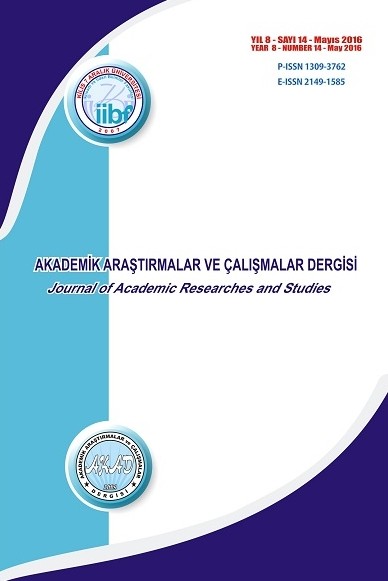DOĞRUDAN YABANCI YATIRIMLARIN BARRO SEFALET ENDEKSİNE ETKİSİ: TÜRKİYE İÇİN SVAR ANALİZİ
Bir ülkenin makroekonomik performansının takip edilip incelenmesi, gerek ekonomi politikalarının etkinliğini ölçme gerekse de ekonomik birimlerin yatırım kararlarını etkilemesi açısından önem arz etmektedir. Bu çalışmanın amacı, doğrudan yabancı yatırımların (DYY) enflasyon oranı, işsizlik oranı, faiz oranı ve ekonomik büyüme oranı verileri ile hesaplanan Barro Sefalet Endeksi üzerindeki etkisini Türkiye için incelemek ve analiz etmektir. Bu amaç doğrultusunda 1985-2017 dönemi için Barro Sefalet Endeksi hesaplanmış olup, DYY arasındaki ilişki SVAR modeli ile analiz edilmiştir. Analiz sonucunda, DYY’nin GSYİH içindeki payı ile reel döviz kuru eş anlı şoklarının, Barro Sefalet Endeksi’ni negatif yönde etkilediği tespit edilmiştir.
Anahtar Kelimeler:
Barro Sefalet Endeksi, Doğrudan Yabancı Yatırımlar, SVAR Analizi
___
- KAYNAKÇAADRANGI, B., & MACRI, J. (2019). “Does the Misery Index Influence a US President’s Political Re-Election Prospects?”, Journal of Risk and Financial Management, 12(1): 22.AYAYDIN, H. (2010). “Doğrudan Yabancı Yatırımlar ile Ekonomik Büyüme Arasındaki İlişkinin İncelenmesi: Türkiye Örneği”, Dumlupınar Üniversitesi Sosyal Bilimler Dergisi, 26(1): 133-145.BARRO, R. J. (1999). ‘Reagan vs. Clinton: Who’s The Economic Champ?’. Business Week, Economic Viewpoint, 22(5).BENLİALPER, A., CÖMERT, H., & DÜZÇAY, G. (2015). 2002 Sonrası Türkiye Ekonomisinin Performansı: Karşılaştırmalı Bir Analiz (Vol. 15, No. 04, pp. 1-45). ERC Working Papers in Economics. BORENSZTEIN, E., DE GREGORIO, J., & LEE, J. W. (1998). “How Does Foreign Direct Investment Affect Economic Growth?”, Journal of International Economics, 45(1): 115-135.BRECHER, R. A., & CHOUDHRI, E. U. (1987). “International Migration Versus Foreign Investment in the Presence of Unemployment”, Journal of International Economics, 23(3-4): 329-342.CARKOVIC, M., & LEVINE, R. (2005). “Does Foreign Direct Investment Accelerate Economic Growth. In The Impact of Foreign Direct Investment on Development: New Measurements, New Outcomes, New Policy Approaches.CAVANAUGH, K. L., & KING, K. D. (1988, August). Simultaneous Transfer Function Analysis of Okun’s Misery Index: Improvements in the Economic Quality of Life through Maharishi’s Vedic Science and Technology of Consciousness. In Proceedings of the American Statistical Association, Business and Economics Statistics Section (pp. 491-496).ÇONDUR, F. (2016). “Türkiye’de Hoşnutsuzluk Endeksi Parametrelerinin Gelişimi”, Atatürk University Journal of Economics & Administrative Sciences, 30(5).DAS, S. P. (1981). “Effects of Foreign Investment in the Presence of unemployment”, Journal of International Economics, 11(2): 249-257.HANKE, S. H. (2009). The Misery Index: A Reality Check for the US and Jamaica. Jamaica Observer, September, 6, 2009.HERMES, N., & LENSINK, R. (2003). “Foreign direct investment, financial development and economic growth” The Journal of Development Studies, 40(1): 142-163.HUFBAUER, G. C., KIM, J., & ROSEN, H. (2008). The Augmented Misery Index. Peterson Institute for International Economics. Çevrimiçi, https://piie.com/sites/default/files/.../hufbauer1008.pdf, Erişim Tarihi: 05.05.2019. HYMER, S. (1970). “The Efficiency (Contradictions) of Multinational Corporations”, The American Economic Review, 60(2): 441-448.IŞIK, M. ve ÇETENAK, Ö. Ö. (2019). “İktisadi Hoşnutsuzluk Endeksi Makroekonomik Performansın Ölçülmesinde Başarılı Bir Gösterge midir?: Türkiye ve BRICS Ülkeleri Üzerine Bir Değerlendirme.”, Uluslararası Ekonomik Araştırmalar Dergisi 4(4) .KINDLEBERGER, C.P. American Business Abroad: Six Lectures on Direct Investment. New Haven and London: Yale University Press, 1969, s.13-16.KWIATKOWSKI, D., PHILLIPS, P. C., SCHMIDT, P., & SHIN, Y. (1992). “Testing the Null Hypothesis of Stationarity Against the Alternative of a Unit Root: How Sure Are We that Economic Time Series Have a Unit Root?”, Journal of Econometrics, 54(1-3): 159-178.LECHMAN, E. (2009) “Okun’s and Barro’s Misery Index as an Alternative Poverty Assessment Toll. Recent Estimations for European Countries”, MPRA, Paper No.37493LI, X., & LIU, X. (2005). “Foreign Direct Investment and Economic Growth: An İncreasingly Endogenous Relationship”, World Development, 33(3): 393-407.MURPHY, R. H. (2016). “A Short Empirical Note on State Misery Indexes”, Journal of Regional Analysis and Policy, 46(1100-2017-1682): 186-189.OKUN, A.M. (1970). The Political Economy of Prosperity. The Brookings Institution Washington D.C.OLOKOYO, F. O. (2012). “Foreign Direct Investment and Economic Growth: A Case of Nigeria”, Journal of Management Research, 4(1): 1-20.PAZARLIOĞLU, M.V. ve GÜLAY, E., (2007). “Net Portföy Yatırımları İle Reel Faiz Arasındaki İlişki: Türkiye Örneği”, Dokuz Eylül Üniversitesi Sosyal Bilimler Enstitüsü Dergisi, 9(2).TULE, K. M., EGBUNA, E. N., DADA, E., & EBUH, G. U. (2017). “A Dynamic Fragmentation of the Misery Index in Nigeria”, Cogent Economics & Finance, 5(1), 1336295.YILDIZ, Ezgi Baday Al İbrahim, (2019). “Türkiye’nin 2006-2017 Dönemi Makroekonomik Performansı: Sihirli Kare Yaklaşımı”, İktisadi ve İdari Bilimler Dergisi, Ocak 2019, 33(1).YILMAZ, K. R., & YILMAZ, D. Ö. Türkiye’de “Bölgesel Ekonomik Hoşnutsuzluk Endeksi” ve Yerel Seçimler: Politik Makroiktisat Bağlamında Bir Analiz. Yerel Yönetimler: Nereye?, 65.ZHANG, K. H. (2006, June). Foreign Direct Investment and Economic Growth in China: A Panel Data Study for 1992-2004. In Conference of WTO, China and Asian Economies, University of International Business and Economics (pp. 24-26).
- ISSN: 1309-3762
- Yayın Aralığı: Yılda 2 Sayı
- Başlangıç: 2009
- Yayıncı: Kilis 7 Aralık Üniversitesi
Sayıdaki Diğer Makaleler
Hakan KALKAVAN, Serkan ETİ, Serhat YÜKSEL
THE EFFECTS OF THE EU FOREIGN POLICY INSTRUMENTS UPON THIRD COUNTRIES
BORÇ YÖNETİMİ: TÜRKİYE ÜZERİNE BİR İNCELEME
SAVUNMA HARCAMALARI İLE EKONOMİK BÜYÜME ARASINDAKİ İLİŞKİNİN ANALİZİ: G8 ÖRNEĞİ
Zeynep KÖSE, Filiz GÖLPEK, Fırat Cem DOĞAN
SİYASAL DÜZEN ÜZERİNE KAVRAMSAL BİR İNCELEME
Ayşe ATILGAN YAŞA, Gonca YÜZBAŞI KÜNÇ
FORDİZMDEN POST-FORDİZME GEÇİŞ SÜRECİNDE KURUMSALCILIĞIN ÖRGÜTLER ÜZERİNDEKİ ETKİSİ
